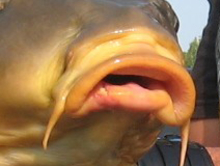Quick facts
Common carp is a regulated invasive species. Regulated Invasive Species (MN DNR) are legal to buy, sell, transport, and possess, but may not be introduced into a free-living state, such as released into public waters.
- Common carp release phosphorus into the water when
feeding, which increases algae growth and turbidity. - Aquatic plant numbers can decline because of reduced water quality and disruption of shallow-rooted plants, potentially impacting habitat for waterfowl, fish and amphibians.
Common carp should be reported. Learn how to report invasive species in Minnesota.
How to identify common carp
- Common carp (Cyprinus carpio) is a brown- to golden- or olive-colored fish with a lighter tan to cream underside.
- Relatively large scales with dark outlines give the fish a spotted or cross-hatched appearance.
- Long dorsal fin and two pairs of barbels on the upper jaw
Life cycle
- Maturity is reached when the fish is around 2–3 years old and 12 inches long.
- Females can carry up to 3 million eggs that hatch within a week after being released and fertilized.
- Adults migrate to shallow areas in the spring to spawn.
- Carp survival is poor in lakes with healthy panfish populations due to predation on carp eggs and larvae.
Reviewed in 2019



